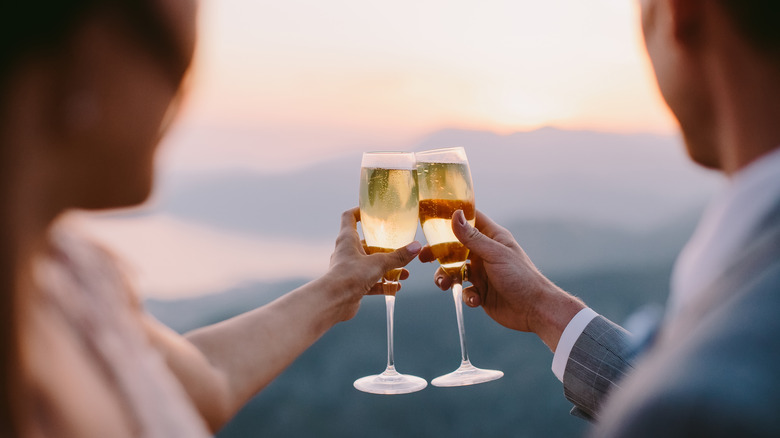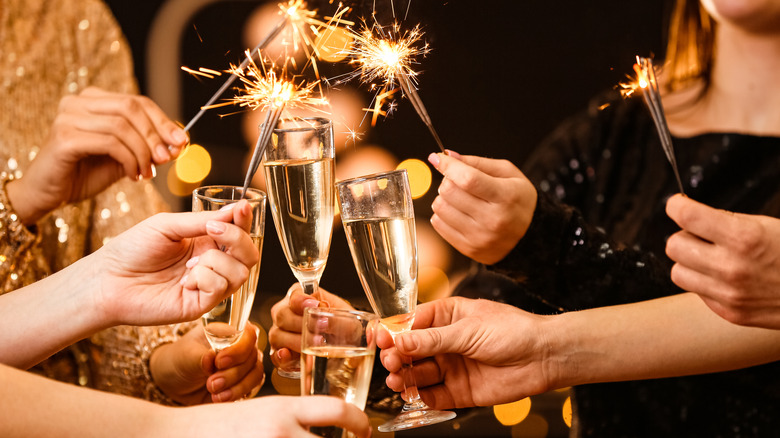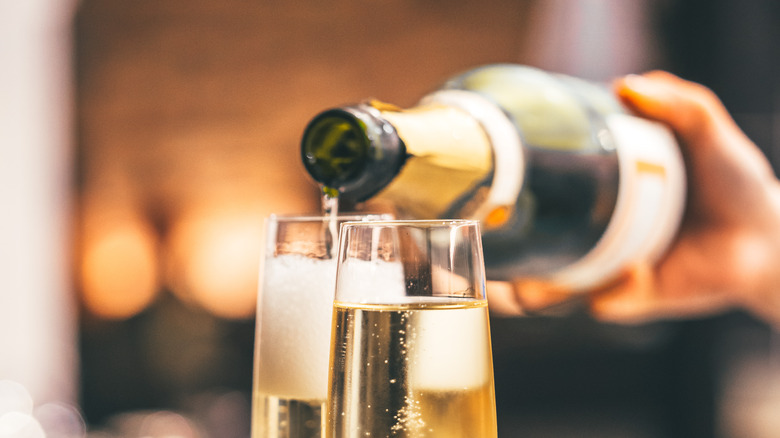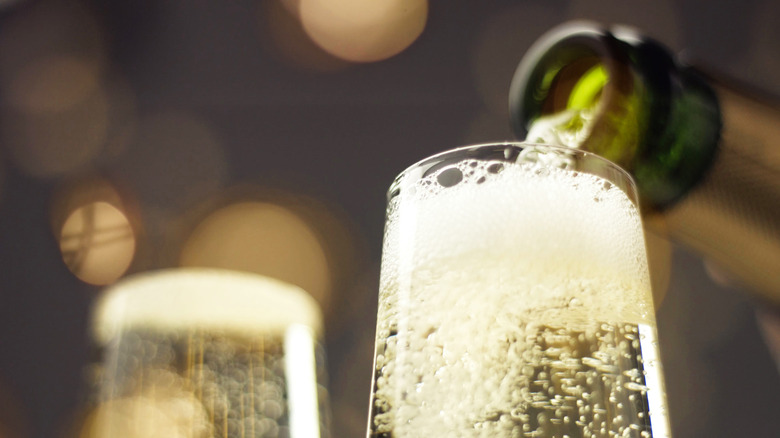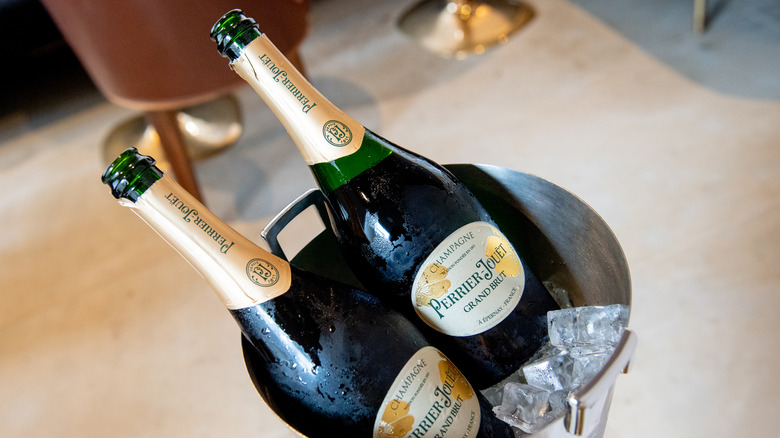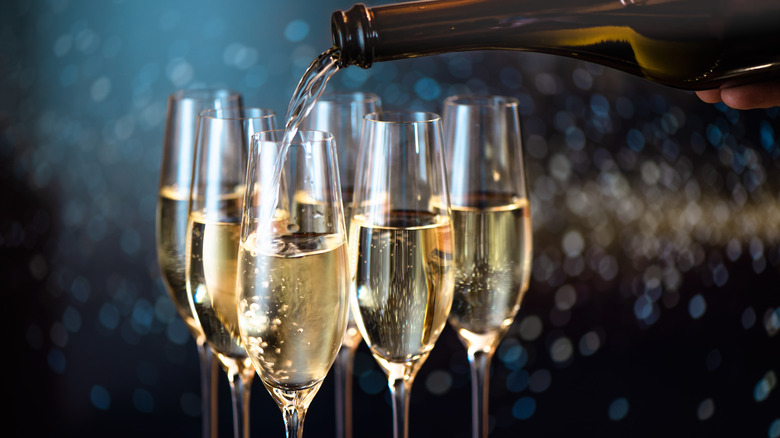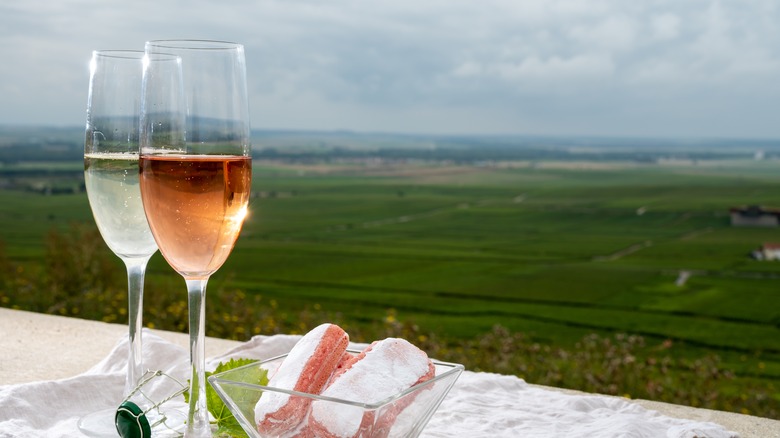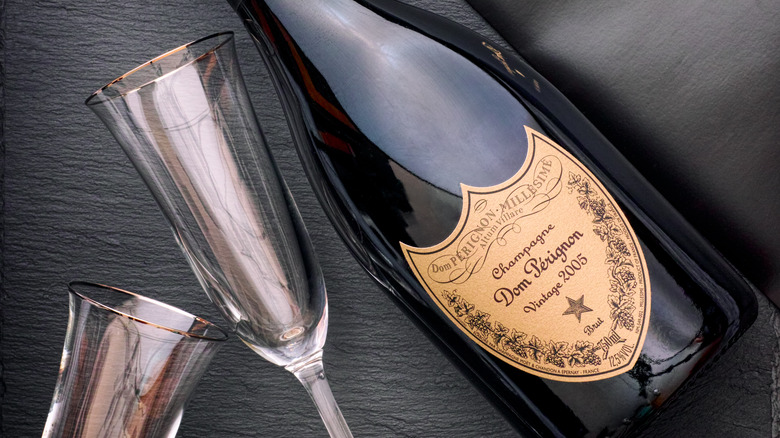What Is Champagne And Why Is It Bubbly?
We all know champagne as a drink for elevated occasions. We sip on it to welcome in the new year, celebrate birthdays, and at graduation send-offs. But why exactly is it our drink of choice for these special moments? Is it the bubbles, the steep price tag, or maybe we just like the taste?
Well, the reason is actually due to an old French tradition. Dom Pérignon was the monk that made the discovery of how to make white wine out of red grapes, and also developed the use of corks. King Louis XV then made the drink popular among the royalty and international nobility, and in all the years following, a champagne bottle has been popped open whenever a celebration is happening.
The bubbles, however, are one of the drink's most defining characteristics. According to Glass of Bubbly, these bubbles form as a result of the second fermentation of the alcohol, which creates the enjoyable, carbonated bubbles to sip on. Here's all there is to know about champagne.
What is champagne?
Champagne is a sparkling wine that is made from grapes grown in the Champagne region of France. The Spruce Eats describes its taste to be balanced in flavor and pale gold to pink in color. Most notably, its bubbles flow up towards the top of a glass when you go to sip it. This is a result of bubbles forming in "nucleation sites," or the imperfections of glasses (via American Scientist). As stated before, the bubbles in champagne come from a second fermentation process. According to Difford's Guide, bubbles almost make champagne what it is — if the drink is too flat, you miss the full experience of enjoying a pleasant glass of fizzy champagne.
Furthermore, according to Science Daily, small bubbles equal a higher quality of champagne, because "basically because there are more bubbles available to release the flavor and aroma," while factors like "dissolved salts, carbohydrates, and minerals" all play a part in determining the size of bubbles in the drink. However, a study reported on by The Guardian states that a fair amount of people actually enjoy bigger bubbles in their champagne.
How is champagne made?
The process for making champagne is pretty over-the-top, which explains its hefty price tag. The first thing to know is that many sparkling wines are called champagne, but it's actually not an official champagne unless the grapes really come from the Champagne region of France. In Europe, it's even illegal to label a wine "Champagne" unless it originates from there (via Southern Living).
The weather of the Champagne region isn't always the most agreeable. Because bad weather can damage bunches, grapes also must be picked by hand. This process is both long and tedious, as you can imagine. The actual production of champagne is just as labor-intensive. According to Taste of Home, the process starts with grape juice being "fermented into a base wine and bottled," before adding in sugar and yeast in the same bottle to start a "second fermentation."
But the process isn't over yet — the wine then needs to age for at least 15 months to be considered "non-vintage," and three years or more to be considered "vintage." You wouldn't expect all of this work just for a "glass of bubbly." Cheers!
Champagne vs. prosecco
As they are both sparkling wines, champagne and prosecco are often confused with one another. What's the difference between the two anyways? In comparing prosecco vs. champagne, one of the main differences lies in their origin. As we discussed, champagne must be made from the grapes hailing from the region of the same name in France, and likewise, prosecco is usually made in Veneto, Italy. They also have different fermentation processes, with prosecco going through what's called the Tank Method (via Decanter).
Champagne also rates stronger on the bubble scale, measured in atmospheres of pressure, than its Italian counterpart, with a usual measurement of six or seven atmospheres of pressure, while prosecco generally has a strength of two to four (via Abilene Reporter News). You've also probably seen prosecco used in an Aperol Spritz, which is everyone's choice drink for the summer. Even though it's basic, we can see why everyone has a soft spot for this light, fruity drink. The prosecco adds the perfect bit of carbonation to the beverage, making it best-suited to enjoy by the poolside or at a rooftop bar with friends.
What does champagne taste like?
Champagne got famous for its light, agreeable flavor, which is why it appeals to the masses to drink when celebrating holidays. You don't have to be a professional wine taster to get fragrant floral notes from smelling a glass of champagne. Other varieties might be more fruity or spicy. For example, Bollinger Brut Special Cuvee is described by Town & Country to have notes of "stonefruit" and "sultry spice."
Furthermore, Luxury Viewer describes the process of tasting champagne as a whole body experience that should involve all senses. In particular, the champagne's palate refers to the feel of the beverage inside the mouth, which can be described as "velvety" or "delicate." Additionally, there is a whole scale that ranks the sweetness of different champagne varieties, with brut being the most neutral in taste (via Wine Folly). Thrillist recommends pairing brut champagne with seafood, as its bubbles will complement nicely with the flavors of many fish dishes.
Where to buy champagne
You can typically find champagne in your local liquor store in the French section. As mentioned before, champagne is a pricy drink, but you can still get a quality bottle for around $40, which isn't too bad (via Town & Country). On the flip side, very expensive champagne can retail for thousands of dollars. You can buy luxury champagne online or at department stores like Harrods. A bottle of the famous Dom Pérignon goes for £165 at Fortnum & Mason.
Some celebrities even have their own lines of the beloved sparkling wine. Jay-Z famously created his Armand de Brignac in 2006, which you can find in stores across the United States, according to Wine Enthusiast Magazine. The 12th and 13th generation wine growers that are behind the rapper's champagne brand are experts in harvesting the finest grapes, according to the company's website. Needless to say, you will always have access to a bottle of bubbly, whatever your budget is.
Nutritional information of champagne
Obviously, when we're holding a toast on a special occasion, we aren't really thinking about the nutritional breakdown of the glass of champagne in our hands. But one noteworthy observation made by nutritionists is that it is generally low in carbs, which might be reassuring to some. According to Everyday Health, one ounce of champagne will typically contain less than one gram of carbs, and variations like brut are lower in calorie than the very dry or sweet kinds. However, like with all alcoholic beverages, too much champagne can be detrimental, as it can lead to hangovers and headaches (via Glass of Bubbly).
But if we're really comparing champagne to other types of alcohol, it does have some health benefits that separate it from the pack. As with other types of wines, it can improve heart health and can lower your risk of diabetes (via Evening Standard). In addition, it usually contains 80 calories per serving, which is significantly lower than the calorie count of many other alcoholic drinks.
Other varieties of champagne
Champagne comes in several varieties, and you can select the one best suited for you based on your flavor preferences. When you buy a bottle of champagne, the label will read one of the following: brut nature; extra brut; brut; extra dry, extra sec, extra seco; dry, sec, seco; demi-sec, demi-seco; or doux, sweet, dulce.
According to The Spruce Eats, this is the scale of how sweet your champagne will be, from least sweet to most sweet. Brut, which is the most popular, sits in the middle, with up to 12 grams of sugar per liter, and it's fairly dry in taste. Champagne can also be categorized based on its overall concentration of grapes.
Blanc de blanc is fully made of chardonnay grapes, while blanc de noirs completely uses "black" grapes. The ever-popular rosé can also be made with champagne, combined with a small dash of red wine.
